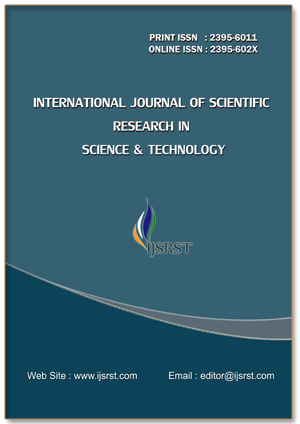Enhanced Temperature Nowcasting via Conv-LSTM Frame wise Modeling
DOI:
https://doi.org/10.32628/IJSRST2512360Keywords:
Conv-LSTM, temperature nowcasting, spatiotemporal modeling, deep learning, weather predictionAbstract
This research introduces an enhanced method for temperature nowcasting through framewise modeling using a Convolutional Long Short-Term Memory (Conv-LSTM) architecture. Unlike traditional numerical models that often fall short in capturing the complex spatiotemporal dynamics of atmospheric data, the proposed approach leverages convolutional layers to extract spatial dependencies and LSTM units to learn temporal sequences, enabling precise short-term temperature prediction. The model is trained on sequential temperature frame data and evaluated using key performance metrics, achieving a Mean Squared Error (MSE) of 0.00035, Peak Signal-to-Noise Ratio (PSNR) of 34.54, Root Mean Square Error (RMSE) of 0.027, and Structural Similarity Index (SSIM) of 0.9954. These metrics demonstrate that the model delivers highly accurate predictions while maintaining the structural integrity and visual quality of the original temperature frames. The exceptionally high SSIM value highlights the model’s ability to preserve spatial consistency, which is vital in meteorological applications. This research underscores the potential of deep learning-based spatiotemporal modeling for accurate and reliable temperature nowcasting and offers a robust framework that can be further extended to other weather prediction tasks requiring fine-grained spatial-temporal understanding.
📊 Article Downloads
References
A. Asperti, F. Merizzi, A. Paparella, G. Pedrazzi, M. Angelinelli, and S. Colamonaco, “Precipitation nowcasting with generative diffusion models,” Springer Nature, 2023, [Online]. Available: http://arxiv.org/abs/2308.06733
S. Imran, T. Anuradha, and R. Bharat, “Radar Based Precipitation Nowcasting Prediction by Using Deep Learning Techniques,” E3S Web of Conferences, vol. 405, pp. 1–9, 2023, doi: 10.1051/e3sconf/202340504003.
W. Liu, Y. Wang, D. Zhong, S. Xie, and J. Xu, “ConvLSTM Network-Based Rainfall Nowcasting Method with Combined Reflectance and Radar-Retrieved Wind Field as Inputs,” Atmosphere, vol. 13, no. 3, 2022, doi: 10.3390/atmos13030411.
G. Czibula, A. Mihai, and E. Mihuleţ, “Nowdeepn: An ensemble of deep learning models for weather nowcasting based on radar products’ values prediction,” Applied Sciences (Switzerland), vol. 11, no. 1, pp. 1–27, 2021, doi: 10.3390/app11010125.
A. Bihlo, “Precipitation nowcasting using a stochastic variational frame predictor with learned prior distribution,” arxiv, 2019, [Online]. Available: http://arxiv.org/abs/1905.05037
V. Bouget, D. Béréziat, J. Brajard, A. Charantonis, and A. Filoche, “Fusion of rain radar images and wind forecasts in a deep learning model applied to rain nowcasting,” Remote Sensing, vol. 13, no. 2, pp. 1–21, 2021, doi: 10.3390/rs13020246.
M. Marrocu and L. Massidda, “Performance Comparison between Deep Learning and Optical Flow-Based Techniques for Nowcast Precipitation from Radar Images,” Forecasting, vol. 2, no. 2, pp. 194–210, 2020, doi: 10.3390/forecast2020011.
S. M. Bonnet, A. Evsukoff, and C. A. M. Rodriguez, “Precipitation nowcasting with weather radar images and deep learning in são paulo, brasil,” Atmosphere, vol. 11, no. 11, pp. 1–16, 2020, doi: 10.3390/atmos11111157.
G. Yao, Z. Liu, X. Guo, C. Wei, X. Li, and Z. Chen, “Prediction of Weather Radar Images via a Deep LSTM for Nowcasting,” Proceedings of the International Joint Conference on Neural Networks, 2020, doi: 10.1109/IJCNN48605.2020.9206889.
[10] S. Samsi, C. J. Mattioli, and M. S. Veillette, “Distributed deep learning for precipitation nowcasting,” 2019 IEEE High Performance Extreme Computing Conference, HPEC 2019, 2019, doi: 10.1109/HPEC.2019.8916416.
A. Kumar, T. Islam, Y. Sekimoto, C. Mattmann, and B. Wilson, “ConvCast: An embedded convolutional LSTM based architecture for precipitation nowcasting using satellite data,” PLoS ONE, vol. 15, no. 3, pp. 1–18, 2020, doi: 10.1371/journal.pone.0230114.
Y. Zhou, H. Dong, and A. El Saddik, “Deep Learning in Next-Frame Prediction: A Benchmark Review,” IEEE Access, vol. 8, pp. 69273–69283, 2020, doi: 10.1109/ACCESS.2020.2987281.
L. Berthomier, B. Pradel, and L. Perez, “Cloud Cover Nowcasting with Deep Learning,” 2020 10th International Conference on Image Processing Theory, Tools and Applications, IPTA 2020, 2020, doi: 10.1109/IPTA50016.2020.9286606.
G. Jianhong, Q. Hui, and H. Wendong, “Research on weather radar nowcasting extrapolation,” Proceedings - 2020 International Conference on Computer Vision, Image and Deep Learning, CVIDL 2020, no. Cvidl, pp. 84–89, 2020, doi: 10.1109/CVIDL51233.2020.00023.
S. Hoyer and J. J. Hamman, “xarray: N-D labeled Arrays and Datasets in Python,” Journal of Open Research Software, vol. 5, pp. 1–6, 2017, doi: 10.5334/jors.148.
S. Goyal et al., “Satellite-based technique for nowcasting of thunderstorms over Indian region,” Journal of Earth System Science, vol. 126, no. 6, pp. 1–13, 2017, doi: 10.1007/s12040-017-0859-2.
S. Sen Roy et al., “A new paradigm for short-range forecasting of severe weather over the Indian region,” Meteorology and Atmospheric Physics, vol. 133, no. 4, pp. 989–1008, 2021, doi: 10.1007/s00703-021-00788-z.
S. Sen Roy, M. Mohapatra, A. Tyagi, and S. K. Roy Bhowmik, “A review of nowcasting of convective weather over the Indian region,” Mausam, vol. 70, no. 3, pp. 465–484, 2019, doi: 10.54302/mausam.v70i3.227.
S. Agrawal, L. Barrington, C. Bromberg, J. Burge, C. Gazen, and J. Hickey, “Machine Learning for Precipitation Nowcasting from Radar Images,” no. NeurIPS, pp. 1–6, 2019, [Online]. Available: http://arxiv.org/abs/1912.12132
R. Suresh, “Forecasting and nowcasting convective weather phenomena over southern peninsular india - part II: Severe local storms,” Indian Journal of Radio and Space Physics, vol. 41, no. 4, pp. 435–447, 2012.
Downloads
Published
Issue
Section
License
Copyright (c) 2025 International Journal of Scientific Research in Science and Technology

This work is licensed under a Creative Commons Attribution 4.0 International License.
https://creativecommons.org/licenses/by/4.0




